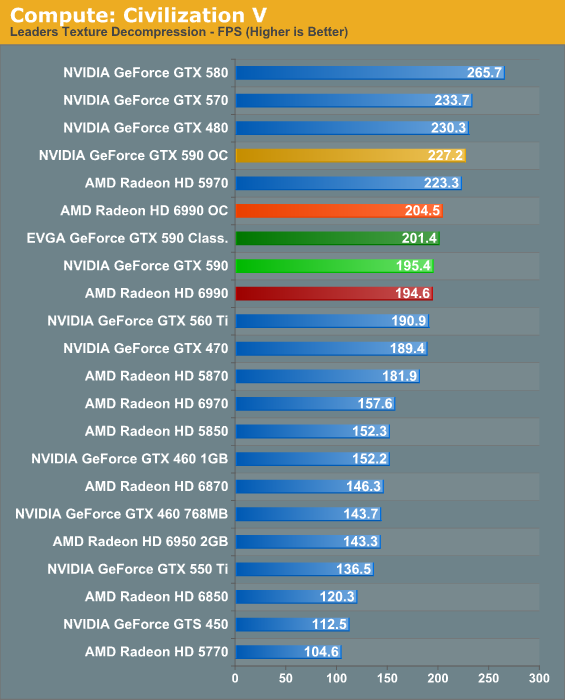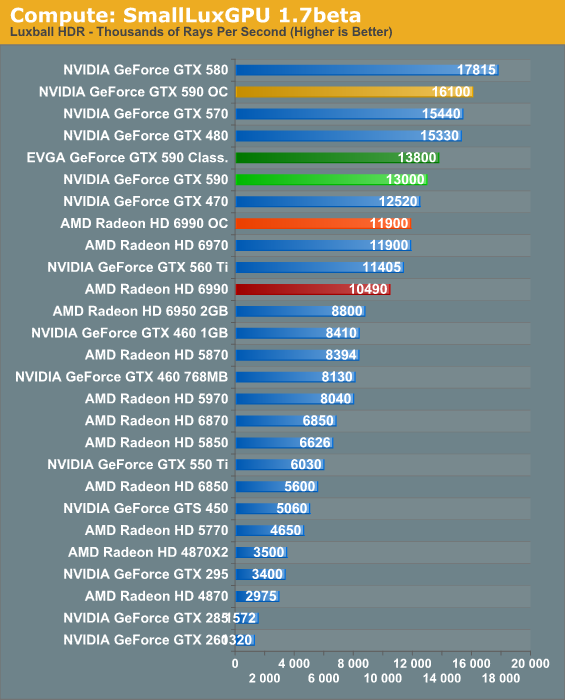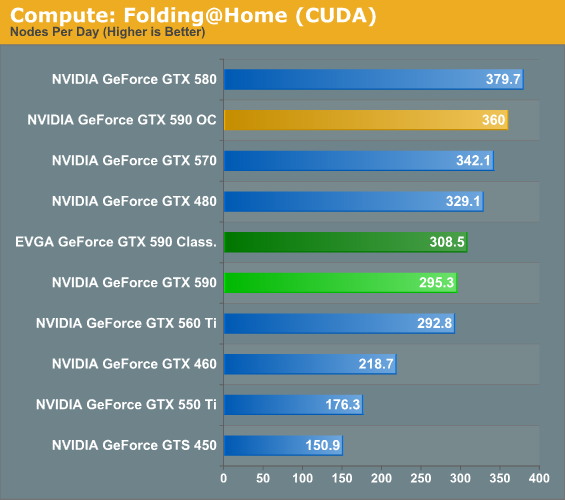NVIDIA’s GeForce GTX 590: Duking It Out For The Single Card King
by Ryan Smith on March 24, 2011 9:00 AM ESTCompute
Moving on from our look at gaming performance, we have our customary look at compute performance.
Our first compute benchmark comes from Civilization V, which uses DirectCompute to decompress textures on the fly. Civ5 includes a sub-benchmark that exclusively tests the speed of their texture decompression algorithm by repeatedly decompressing the textures required for one of the game’s leader scenes.

In the game world Civ5 benefits significantly from SLI and CrossFire. For our texture compression test however AFR is more a liability than a benefit. This doesn’t impact the game in any meaningful manner, but it’s an example of how SLI/CF aren’t always the right tool for the job. Unfortunately for both parties, with as few compute applications as there are today, almost none of them benefit from SLI/CF.
Our second GPU compute benchmark is SmallLuxGPU, the GPU ray tracing branch of the open source LuxRender renderer. While it’s still in beta, SmallLuxGPU recently hit a milestone by implementing a complete ray tracing engine in OpenCL, allowing them to fully offload the process to the GPU. It’s this ray tracing engine we’re testing.

SmallLuxGPU only currently supports ray tracing with one GPU, so all of our results are effectively proxies for what would be if the GTX 590 only had one GPU. Not surprisingly overclocks do wonders here, and NVIDIA’s strong compute architecture gives them an easy win. SLI/CF performance will become more important here when we upgrade to LuxMark for our next iteration of our benchmark suite, as LuxMark can handle multiple OpenCL drivers.
Our final compute benchmark is a Folding @ Home benchmark. Given NVIDIA’s focus on compute for Fermi, cards such as the GTX 590 can be particularly interesting for distributed computing enthusiasts, as two GPUs should be able to quickly retire work units.

Folding@Home doesn’t directly benefit from CF/SLI at all. However by dispatching one WU to each GPU it’s possible to double effective performance. With that taken into account the GTX 590 is quite an effective cruncher, particularly when we start looking at overclocking.










123 Comments
View All Comments
BreadFan - Thursday, March 24, 2011 - link
Would this card be better for the P67 platform vs GTX 580's in sli considering you won't get full 16x going the sli route?Nfarce - Thursday, March 24, 2011 - link
The 16x vs. 8x issue has been beaten to death for years. Long story short, it's not a measurable difference at or below 1920x1080 resolutions and only barely a difference above that.BreadFan - Thursday, March 24, 2011 - link
Thanks man. Already have one evga 580. Only reason I was considering was for the step up program evga offers (590 for around $200). I have till first part of June to think about it but am leaning towards adding another 580 once the price comes down in a year or two.wellortech - Thursday, March 24, 2011 - link
You won't get 16x going the CF route either.....although I agree that it doesn't really matter.softdrinkviking - Sunday, March 27, 2011 - link
i hope your screen name is from the budgie song!softdrinkviking - Sunday, March 27, 2011 - link
that comment was to breadfan.7Enigma - Thursday, March 24, 2011 - link
Comon guys, I would have thought you could have at least had the 6990 and the 590 data points for Crysis 2. Perhaps a short video as well with the new game? :)Ryan Smith - Thursday, March 24, 2011 - link
It's unlikely we'll be using Crysis 2 in its current state, but that could always change.However if we were to use it, it won't be until the next benchmark refresh.
YouGotServed - Friday, March 25, 2011 - link
Crysis: Warhead will always be the benchmark. Crysis 2 isn't nearly as demanding. It's been dumbed down for consoles, in case you haven't heard. There are no advanced settings available to you through the normal game menu. You have to tweak the CFG file to do so.I thought like you, originally. I was thinking: Crysis 2 is gonna set a new bar for performance. But in reality, it's not even close to the original in terms of detail level.
mmsmsy - Thursday, March 24, 2011 - link
I know I can be annoying, but I checked it myself and the built in benchmark in Civ V really favours nVidia cards. In the real world scenario the situation is almost upside down. I got a reply from one of the reviewers last time that it provides quite accurate scores, but I thought that just for the heck of it you'd try and see for yourself that it doesn't at all. I know it's just one game and that benchmarking is a slow work, but in order to keep up the good work you're doing you should at least use the advice and confront it with the reality to stay objective and provide the most accurate scores that really mean sth. I don't mean to undermine you, because I find your articles to be mostly accurate and you're doing a great job. Just use the advice to make this site even better. A lot of writing for a comment, but this time maybe you will see what I'm trying to do.